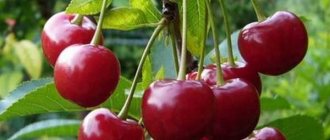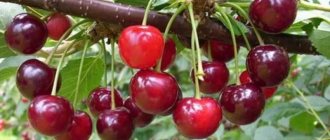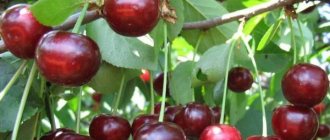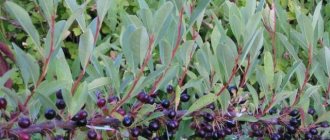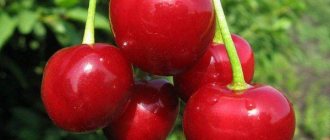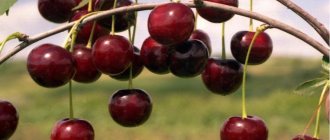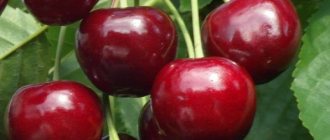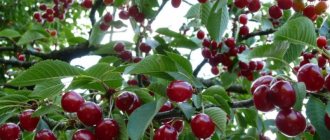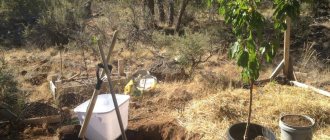Advantages and disadvantages
The main advantages for which the variety is recommended for cultivation are:
- high yield;
- excellent taste of fruits;
- early entry into the fruiting stage, subject to all agricultural techniques;
- good transportability, which ensures long-term preservation of the marketable appearance of the crop;
- Compact, easy to maintain.
In addition to the advantages, it is important to identify the disadvantages, which include:
- average frost resistance;
- demands on climate conditions.
There is also a need to plant a pollinator, since the variety is endowed with partial self-fertility. Primetnaya, Shalunya, and Lyubskaya cherries will serve as pollinators.
Pros and cons of the variety
Characteristics
When choosing cherries, take into account its resistance to drought, frost, diseases and pests. If necessary, select a pollinator variety.
Drought resistance, winter hardiness
Hybrid Vstrecha has good drought resistance and can tolerate lack of moisture. To increase productivity, it is recommended to water the tree during flowering and at the beginning of fruiting.
The winter hardiness of the Vstrecha variety is quite low. The tree tolerates winter frosts down to – 25 °C.
Pollination, flowering period and ripening time
The Vstrecha variety blooms at the end of April or beginning of May. The variety is partially self-fertile. To obtain a high yield, pollinator planting is required.
The best pollinators for the Vstrecha hybrid are dwarf varieties that bloom at the same time. Lyubskaya, Primetnaya, Samsonovka, Shalunya cherries are planted next to the tree.
Harvesting begins at the end of June. The fruits remain on the branches for a long time after ripening.
Productivity, fruiting
Fruiting of the Vstrecha variety begins 3-4 years after planting the seedling. The harvest ripens on one-year-old shoots.
The yield of the variety is high - about 25 kg of fruits per bush. Fruiting is stable from year to year. The average lifespan of a tree is 20 years, after which the plantings are replaced.
Area of application of berries
Due to its dessert taste, Vstrecha cherry is suitable for fresh consumption and making desserts. The fruits tolerate transportation and freezing well. A variety of homemade preparations are obtained from it: jam, compotes, juices, marshmallows.
Resistance to diseases and pests
Cherry resistance to diseases and pests is assessed at an average level. The tree is immune to moniliosis and coccomycosis.
A mandatory stage of care is carrying out preventive treatments. Fungal diseases that spread in high humidity are especially dangerous for wood.
Advantages and disadvantages
The main advantages of the Meeting cherry:
- high productivity;
- easy care due to the low growth of cherries;
- quickly begins to bear fruit;
- commercial and taste qualities of fruits.
The disadvantages of the Vstrecha variety include:
- the need to plant a pollinator;
- average frost resistance;
- demands on climatic conditions.
Appearance
Cherry Vstrecha belongs to the dwarf varieties, the advantages of which are compactness and ease of care. Such plants quickly take root and grow after planting.
Height and dimensions of an adult tree
A tree up to 2.5 m high with a wide, dense spherical crown and drooping shoots. The plant is decorated with foliage that has an oval shape and a jagged edge. The length of the leaf blade is 8 cm, the color is green, with the upper part being darker and the lower part being pale.
The culture pleases with flowering from late April to mid-May. The flowers are collected in small umbrella inflorescences of white or pink shade.
Cherry tree
Fruit
The Vstrecha variety is prized for its large, dark red, rounded fruits. The weight of each cherry varies from 8 to 15 g. The skin is characterized by density and thinness.
The pulp is juicy, tender, deep red in color. The stone is round, slightly flattened on the sides, is of medium size, and is easily separated from the pulp.
For reference! Thanks to its pleasant sweet and sour dessert taste, cherries received the highest rating - 5 points.
Description of fruits
Diseases and pests, methods of control and prevention
Despite the resistance of the hybrid Meeting to diseases, under certain conditions signs of damage may appear on the tree.
Common diseases to which cherries are susceptible are shown in the table:
| Disease | Symptoms | Control measures | Prevention |
| Moniliosis | First, the cherry shoots and leaves dry out. Then gray growths appear and the fruits rot. | The affected parts of the tree are cut off and destroyed. Cherries are sprayed with Bordeaux mixture or Cuprozan. |
|
| Cocomycosis | The appearance of round brown spots on the leaves. As a result, the leaves fall and the bush dies. | Spraying with Bordeaux mixture or copper oxychloride. | |
| Anthracnose | Brown spots on the surface of fruits that grow rapidly. | Removing the affected fruits and spraying the bush with Poliram. |
The table shows the main cherry pests:
| Pest | Signs of defeat | Control measures | Prevention |
| Aphid | It feeds on the juice of young leaves. The pest is identified by curled leaves. | Spraying with solutions of Phosfamide or Fitoverm. |
|
| Weevil | Eats ovaries and gnaws holes in leaves. | Spraying with insecticides Fufanon, Actellik. | |
| Sawfly | The larvae eat the top layer of leaves, which begin to fall off. | Spraying with Kemifos. |
Features of planting and care
In order for the cherry tree to develop normally, and for the harvest to please you with its quantity and quality, you need to plant the plant correctly, as well as carry out all the care measures.
Recommended timing
Planting work should be planned for mid-April - early May. Plant seedlings after the soil has warmed up, but before the buds swell.
The procedure can also be carried out in September - early October, since the tree can take root normally in just a few weeks.
Site selection and soil preparation
The site for placing Vstrecha cherries must meet a number of requirements:
- good lighting:
- lack of through winds;
- drained fertile soil (loam, sandy loam soil of neutral reaction).
The plant feels comfortable in flat areas where its root system is not exposed to moisture; because of this, lowlands and slopes are not suitable for planting.
It is necessary to prepare the planting site in advance, about a month before the start of work, by digging up the soil and clearing it of weeds. It is important to enrich the soil with a complex of fertilizers (wood ash, superphosphate, potassium sulfate).
Site preparation
What crops can and cannot be planted next to cherries?
It is important to choose the right location and soil, as well as good neighbors. It is better to grow cherries next to stone fruits: cherries, grapes, elderberries, plums, cherry plums. When adjacent to rowan and hawthorn, fruiting will increase in both crops.
Bad neighbors for this crop: apple trees, pears, peaches, apricots, because they have a spreading crown that will obscure the cherries.
Important! Tall plants with a height of more than 3.5 m should not be located nearby. The permissible distance between the cherry tree and other trees is 5-6 m.
Selection and preparation of planting material
For planting, you need to choose seedlings 50-60 cm in height with a branched root system. High quality planting material should not have any damage or traces of fungal infections or harmful insects.
4 hours before planting, immerse the roots of the seedlings in water, after adding a growth stimulator to it.
Subsequent care of the crop
Dwarf cherry trees are pruned before or after the start of sap flow. For each bush, 5-10 of the strongest shoots are left. Be sure to remove dry, broken and frozen branches.
Hybrid Meeting is enough to water 3-5 times per season. The shrub requires moisture at the flowering stage and at the beginning of fruiting. 2-3 liters of water are poured under the bush.
Advice! Watering can be combined with fertilizing. In early spring, the tree is watered with slurry, and during and after flowering - with potassium-phosphorus solutions.
To prepare the Vstrecha cherry for winter, its trunks are hilled up and the soil is mulched with humus. The young seedling is covered with a net or roofing felt to protect it from rodents, and in winter a snowdrift is placed on top.
Description of the cherry variety Vstrecha
The Vstrecha cherry variety is a hybrid obtained by crossing the Lyubskaya cherry and the Kyiv-19 duka (a hybrid of cherry and sour cherry). This tree is classified as a natural dwarf tree, since it grows weakly and does not exceed a height of 2 m. The spherical crown with drooping branches and large, rich green leaves with small serrations has a compact and attractive appearance.
The meeting attracts gardeners with its compactness of the tree and abundant fruiting
The variety is a mid-late variety and blooms from April 25 to May 5. Flowering and fruit formation occur on emerging young growths and bouquet branches of a four to five year old tree. The first berries begin to ripen in the second half of June (depending on the climate zone). The average weight of the fruit reaches 10 g. Shiny, with a dense dark red skin and sweet pulp, from which the stone can be easily separated, the fruits evoke the admiration of even the most experienced breeders. The form and “content” do not lag behind in assessments. The taste of the berries was rated by tasters with the highest score - 5. High yield (up to 28 kg per mature tree), versatility of the fruit in terms of use and suitability, excellent transportation of fresh berries are big advantages of their characteristics. Therefore, Vstrecha is ideal for growing both a single crop in dachas and individual farms, and in group plantings for commercial purposes.
An important advantage of cherries is its increased immunity to common crop diseases - coccomycosis and moniliosis, resistance to the arid steppe climate and severe frosts (down to -25 ° C). Unlike other varieties, Vstrecha grows well and bears fruit in the shade.
Cherry is recommended for cultivation not only in Ukraine, where it was bred by Melitopol breeders Turovtsev, but also in all zones of the former Union, excluding the northern one.
Cherry Vstrecha will be glad to have such “neighbors” as cherries and grapes. But do not try to test it with the proximity of currants, plums, apricots, peach, walnuts, pears.
Since the variety is partially self-fertile, the cherry varieties Lyubskaya, Primetnaya, Shalunya, as well as the cherries Valery Chkalov and Krupnoplodnaya will be an excellent addition to Vstrecha as third-party pollinators.
Video: Cherry Meeting
Description of fruits
The size of the Vstrecha cherry fruit is large, the weight of one berry averages 9-10 g, individual berries reach 15 g in weight. In general they are approximately equal in size. The shape of a cherry is a somewhat flattened ball. With such outstanding size of the berries, the stone is medium, it is easy to separate it from the tender pulp that melts in the mouth. The thin, shiny skin is dark red, but nevertheless quite dense. It separates from the pulp quite easily.
Planting Lyubskaya cherry
Planting a Lyubskaya cherry seedling is not difficult.
Landing dates
The crop can be planted in autumn or spring:
- spring planting is the best option, as the plant takes root better and the possibility of freezing is eliminated. It is necessary to plant before the buds begin to bloom;
- Autumn planting is also possible, but it is better to avoid it, since there is no guarantee that the seedling will not freeze. If for some reason you need to plant it in the fall, it should be the end of October - beginning of November.
Selection and preservation of seedlings
It is better to purchase seedling(s) in the fall, even if planting is planned for spring. In this case, by the time of planting, you are guaranteed to have high-quality planting material, while in the spring before the buds begin to open, it is not always possible to purchase the required seedling.
It is better to purchase cherry seedlings in the fall, and plant them in the spring.
The seedling must be one year old or maximum two years old. Older ones take root worse and develop poorly; you should not expect a good harvest from them. A one-year-old seedling usually has a height of 70-80 cm, a two-year-old - 100-110 cm. The bark should be silky brown without greenish inclusions, the root system should be well defined.
If you bought a seedling in the fall and will plant it in the spring, then in order to save it you need to:
- Dig a trench 30–40 cm wide and deep and about a meter long.
- Place the seedling horizontally in the trench so that its crown is above the ground.
- Cover the roots and trunk with earth, and protect the crown well from freezing and rodents.
This way the seedling will be well preserved until planting.
Preparing the planting hole
Cherry Lyubskaya loves light, well-drained soils. It grows better on small (8–10°) slopes, preferably western or northwestern. It feels better on the northern slopes than on the southern ones. The place should be well ventilated, without flooding. Do not plant in lowlands or ravines. For group plantings, the distance between rows is 3 m, between trees in a row - 2.5–3 m.
It is better to prepare the planting site in the fall. To do this you need:
- Dig holes 40–60 cm deep and 60–70 cm wide (diameter).
- Pour the top fertile layer into the hole, adding 10 kg of humus, a liter of ash, 150–200 g of superphosphate and mixing.
History of the Meeting
The homeland of the variety is Ukraine - the Vstrecha cherry appeared in 1966 in Melitopol (to be more precise, at the Institute of Irrigated Horticulture named after M. F. Sidorenko NAAS). The selection was carried out by Nikolai Ivanovich and Valentina Alekseevna Turovtsev, who were later assigned the authorship of the variety. The role of “parents” of the Meeting was a national selection cherry called Lyubskaya and Duke (that is, a hybrid of cherry and cherry) Kyiv-19.
The valuable and large-fruited variety Vstrecha appeared as a result of crossing the Lyubskaya cherry with the Kyiv-19 duke
In 1995, Vstrecha was included in the State Register of Plant Varieties of Ukraine under the identifier 82074001 as a universal mid-late variety, and zoned for the steppe zone.
Planting
Where will it be better to grow Vstrecha cherries? The description of the variety indicates that other trees of the Shalunya, Primetnaya, Lyubskaya varieties should grow not far from it. Neighborhood with them will help the partially self-pollinating Meeting significantly increase the number of fruits.
When choosing a place for cherries, you need to take into account that they will grow better in sunny areas.
The cherry tree is not very demanding on the soil. It needs to be drained. Then the moisture will not stagnate near the root. It is good if it is sandy loam or light loam.
Cherries are not planted:
- in drafts;
- in low areas;
- near tall trees;
- near apricots, pears, plums, walnuts, currants.
Apple, cherry, and hawthorn will be good neighbors for it.
It is best to plant cherry trees in the southern regions in the fall, at least a month before the onset of frost. If you didn’t have time to do this, it’s better to bury it until spring.
In mid-April it is usually time to plant cherries in the middle zone.
Preparing a hole for planting a tree. Its depth should be at least 80 cm. You can determine the size of the hole by adding 20-30 cm to the dimensions of the root system. The soil selected from the hole is mixed with rotted manure, sand, superphosphate, and potassium chloride.
Fill the hole halfway and add a pile of soil to install the root. Plant a seedling. A wooden stake is prepared, which will subsequently support the young tree, protecting it from gusts of wind. Level the roots and sprinkle them with prepared soil.
Water generously until water is absorbed into the soil.
Tie the seedling to a support.
Mulch the tree trunk circle with grass; the thickness of the mulch layer should be about 7 cm. An exception may be prolonged rainy weather, when moisture collects in the mulch layer. This can lead to rotting of the root collar. In this case, it is better to remove the mulch layer before the heat comes.
When planting in the fall, the tree trunk circle is mulched with a 20 cm layer of manure; in winter, as much snow as possible is poured on it.
If several trees are planted, the distance between them should be at least 3 meters.
Selection of seedlings
Cherry tree variety Meeting
Seedlings should not have signs of disease (damaged bark, yellow leaves with spots), a well-developed root system.
Usually they sell one-year-old or two-year-old plants up to one meter high. It is recommended to plant young trees in the spring before buds open.
Cherry planting Meeting
It is not recommended to plant seedlings in lowlands, in drafts, or next to tall trees.
The soil in the prepared pit is mixed with mineral fertilizers (potassium chloride, superphosphate, sand).
Areas with sandy loam or light loamy soil where trees have not previously grown are best suited for planting. The young plant is not buried, leaving the root collar above the ground level. The distance between seedlings is 3 – 4 meters. A deep hole is made around the tree for convenient watering.
Features of cultivation
To grow high-quality berries, cherries need special conditions. To do this, the tree should be provided with an appropriate microclimate, as well as a special composition of the soil mixture. Before planting a seedling, it is necessary to carefully inspect the area of the site and accurately determine all its features.
Climatic conditions
Cultivated cherry varieties develop best in southern and temperate climates. The optimal temperature for growing the plant is considered to be +25°C, however, the Meeting can actively develop at +15°C. In heat above +30°C, the tree grows weakly, so the cherry must be protected not only from cold, but also from heat. The optimal humidity for the crop is about 60%, while a short-term increase in the indicator to 80% does not negatively affect cherries.
Important! Cherries are planted away from the following plants: pear, apple, apricot, birch, oak, maple, linden.
You should maintain a distance of at least 5–6
meters
.
The meeting does not like drafts, so it is planted only in a place protected from cold winds. To avoid low yields, the plant is planted only in a well-lit place. In addition, seedlings must be located in the southern part of the garden, at a distance of 3–4 m from other fruit trees and no closer than 1.5 m from any bushes and garden fences.
Soil for a tree
The soil mixture for growing crops should be light, with a low moisture capacity. In arid regions, loams are suitable for this; in areas of moderate moisture, sandy loam substrates are suitable. The plant does not require highly fertile soils, so it can grow safely even on poor soils.
However, saturating the soil with all kinds of organic mixtures has a positive effect not only on the growth, but also on the fruiting of cherries. It is also worth mentioning that Vstrecha is demanding on soil pH. The variety does not tolerate acidic soils; its representatives grow best on neutral substrates with a pH in the range of 6.7–7.1.
